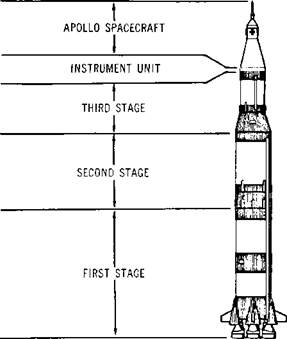Apollo Saturn V News Reference
This volume has been prepared by the five Saturn V major contractors: The Boeing Company; Douglas Aircraft Company: Space Division of North American Aviation, Inc.; Rocketdyne Division of North American Aviation, Inc.; and International Business Machines Corporation in cooperation with the National Aeronautics and Space Administration.
It is designed to serve as an aid to newsmen in present and future coverage of the Saturn V in its role in the Apollo program and as a general purpose large launch vehicle. Every effort has been made to present a comprehensive overall view of the vehicle and its capabilities, supported by detailed
The Boeing Company P. 0. Box 29100 New Orleans, La. 70129 Attention: William W. Clarke
Douglas Aircraft Company Missile & Space Systems Division Space Systems Center 5301 Bolsa Avenue Huntington Beach, Calif. 92647 Attention: Larry Vitskv
International Business Machines Corporation
Federal Systems Division
150 Sparkman Drive
Huntsville, Ala. 35807
Attention: James F. Harroun
information on the individual stages and all major systems and subsystems.
Weights and measurements cited throughout the book apply to the AS-501 vehicle, the first flight version of the Apollo/Saturn V.
All photographs and illustrations in the book are available for general publication. The first letter in each photo number is a code identifying the organization holding that negative: В for Boeing; R for Rocketdyne Division of North American; D for Douglas; IBM for IBM; S for Space Division of North American; H for NASA, Huntsville, Ala.; and К for NASA, Kennedy Space Center, Fla.
s are:
Rocketdyne Division
North American Aviation, Inc.
6633 Canoga Avenue Canoga Park, Calif. 91304 Attention: R. K. Moore
National Aeronautics and Space Administration George C. Marshall Space Flight Center Public Affairs Office Huntsville, Ala. 35812 Attention: Joe Jones
National Aeronautics and Space Administration Public Affairs Office Kennedy Space Center, Fla. 32931 Attention: Jack King
Space Division
North American Aviation, Inc. Seal Beach, Calif. 90241 Attention: Richard E. Barton
^ SATURN V NEWS REFERENCE
SATURN V FACT SHEET
|
|
|
PHYSICAL CHARACTERISTICS OVERALL VEHICLE |
DIAMETER |
HEIGHT |
WEIGHT |
|
33 ft. |
364 ft.* |
6,100,000 lb. |
|
|
FIRST STAGE |
33 ft. |
138 ft. |
(total liftoff) 300,000 lb. (dry) |
|
SECOND STAGE |
33 ft. |
81 ft. 7 in. |
95,000 lb. (diy)‘ |
|
THIRD STAGE |
21 ft. 8 in. |
58 ft. 7 in. |
34,000 lb. (dry)’ |
|
INSTRUMENT UNIT |
21 ft. 8 in. |
3 ft. |
4,500 lb. |
|
APOLLO SPACECRAFT |
80 ft. |
95,000 lb. |
‘SINCE INDIVIDUAL STAGE DIMENSIONS OVERLAP IN SOME CASES, OVERALL VEHICLE
LENGTH IS NOT THE SUM OF INDIVIDUAL STAGE LENGTHS
“INCLUDES AFT INTERSTAGE WEIGHT
PROPULSION SYSTEMS
FIRST STAGE —Five bipropellant F-l engines developing 7,500,000 lb. thrust
RP-1 Fuel-203,000 gal. (1,359,000 lb.), LOX-331,000 gal. (3,133,000 lb.)
SECOND STAGE Five bipropellant J-2 engines developing more than 1,000,000 lb. thrust LH2—260,000 gal. (153,000 lb.), LOX-83,000 gal. (789,000 lb.)
THIRD STAGE —One bipropellant J-2 engine developing up to 225,000 lb. thrust LH2—63,000 gal. (37,000 lb.), LOX—20,000 gal. (191,000 lb.)
CAPABILITY
FIRST STAGE —Operates about 2.5 minutes to reach an altitude of about 200,000 feet (38 miles) at burnout
SECOND STAGE Operates about 6 minutes from an altitude of about 200,000 feet to an altitude of 606,000 feet (114.5 miles)
THIRD STAGE —Operates about 2.75 minutes to an altitude of about 608,000
feet (115 miles) before second firing and 5.2 minutes to translunar injection
PAYLOAD —250,000 lb. into a 115 statute-mile orbit
I SATURN V NEWS REFERENCE











